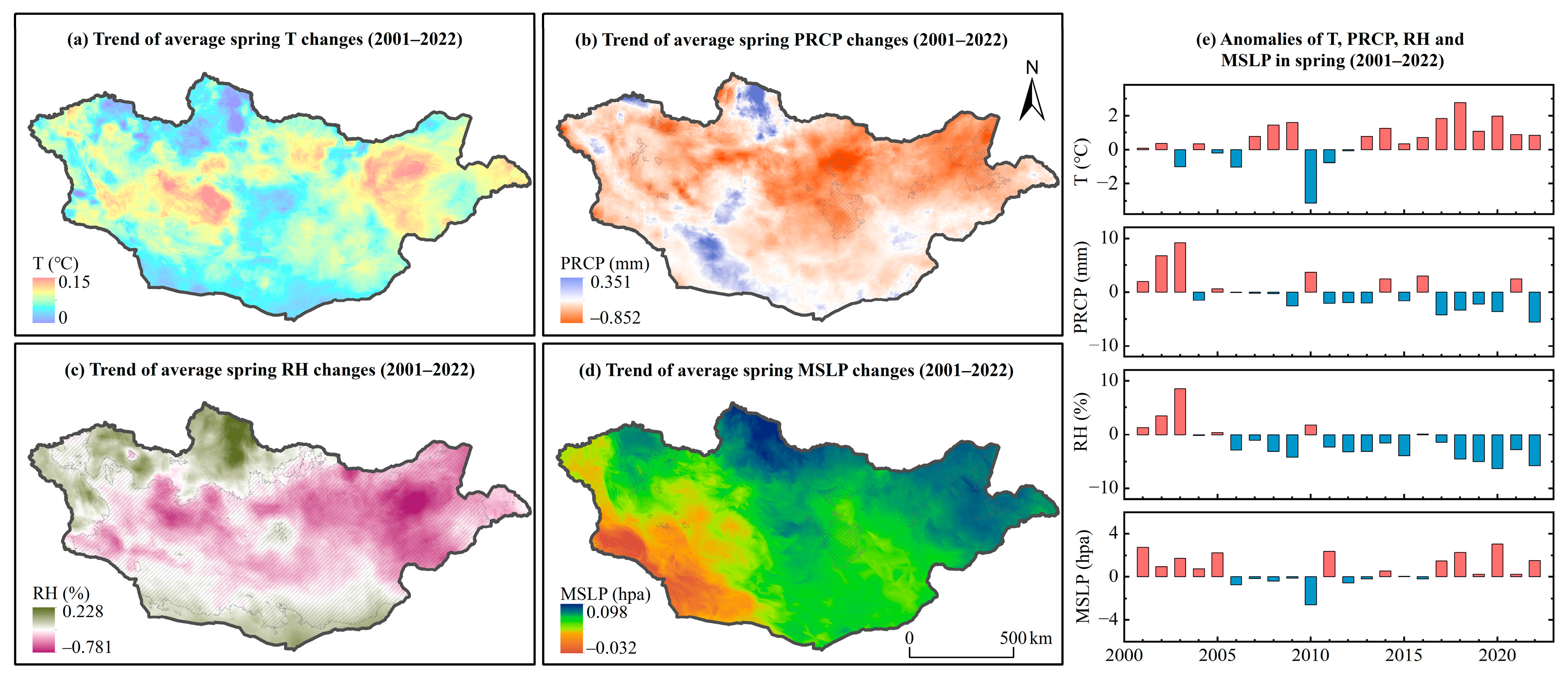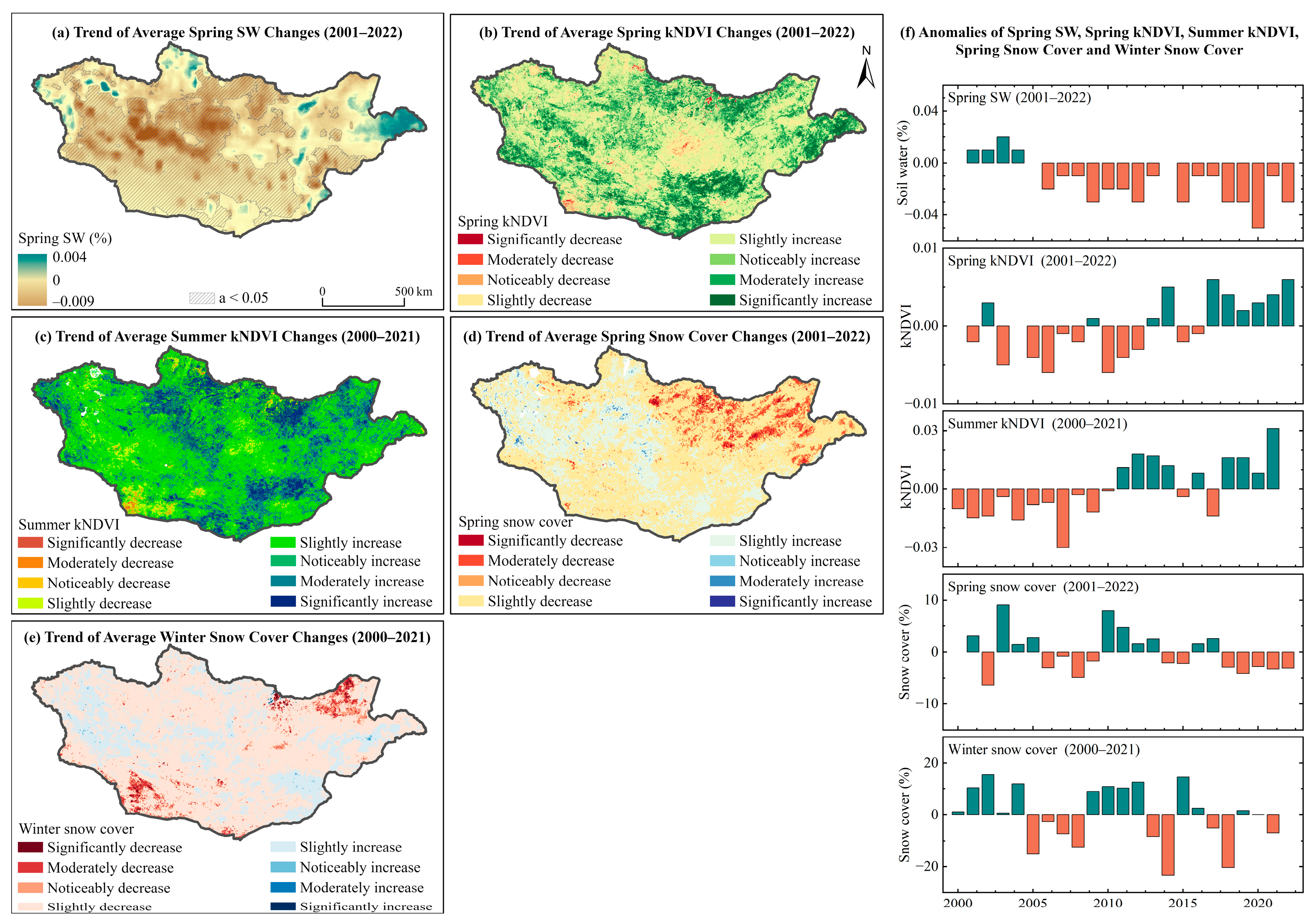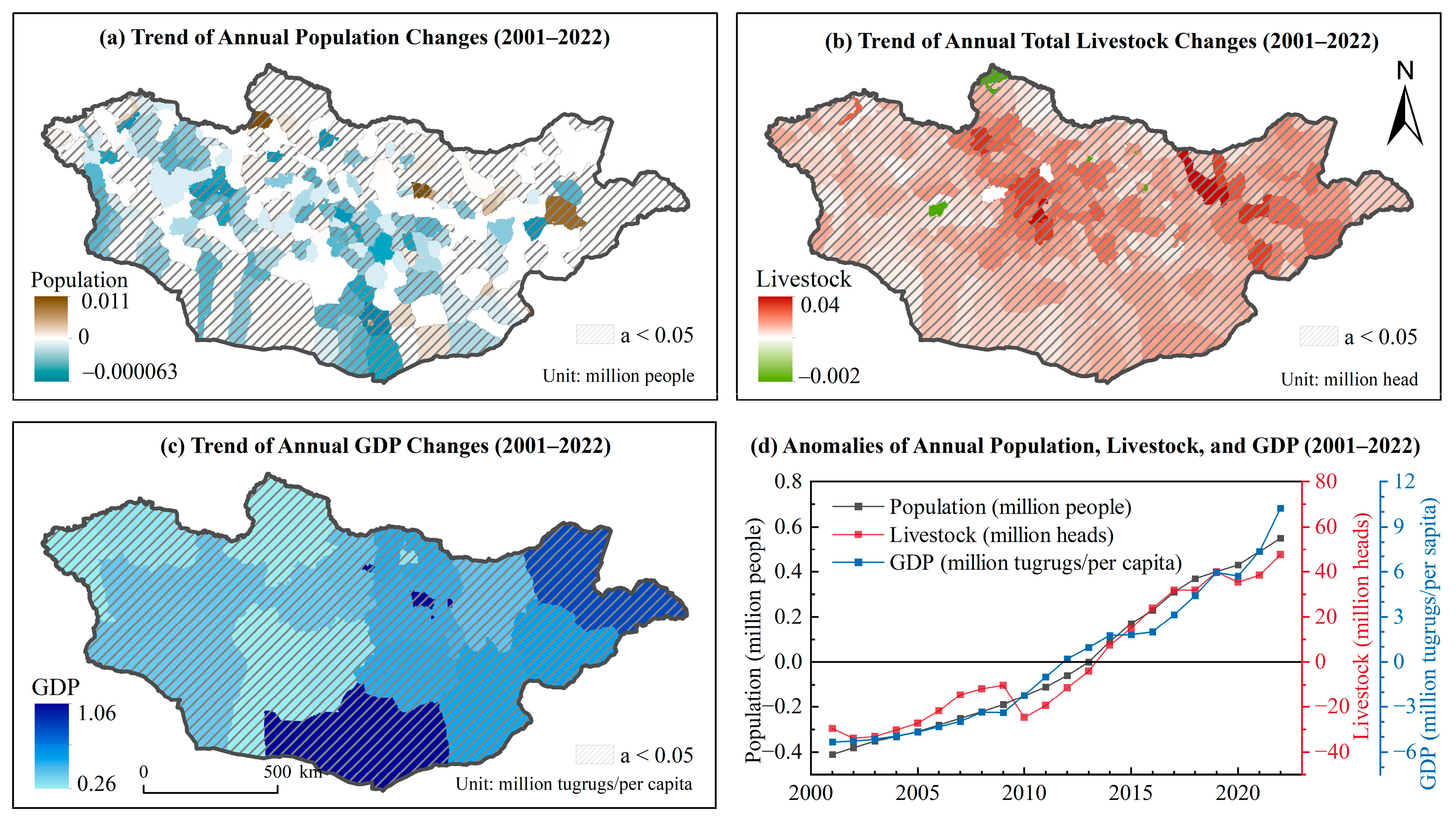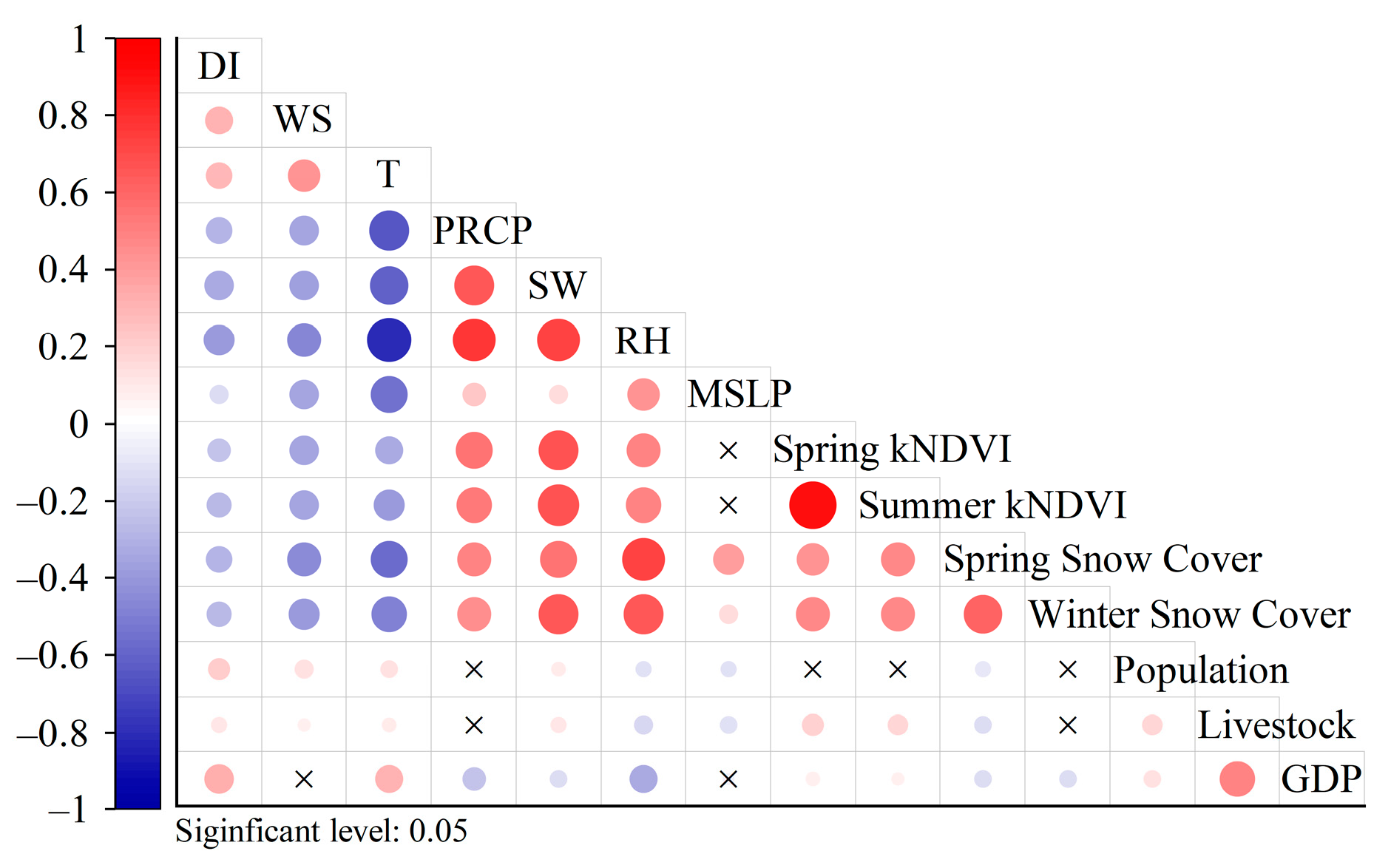Dust Intensity Across Vegetation Types in Mongolia: Drivers and Trends
Abstract
1. Introduction
2. Materials and Methods
2.1. Study Area
2.2. Materials
2.3. Methods
2.3.1. Dust Intensity (DI) and Maximum Wind Speed (WS)
2.3.2. Theil–Sen Median and Mann–Kendall
2.3.3. Feature Importance
3. Results
3.1. Enhancement in Dust Intensity over the Past Two Decades
3.2. Variations in Impact Factors of Dust Intensity
3.2.1. Climate Factors
3.2.2. Underlying Surface Conditions
3.2.3. Anthropogenic Factors
3.3. Importance of Impact Factors on Dust Intensity
4. Discussion
4.1. Dust Intensity Spatiotemporal Variability
4.2. Impacts Factors of Spatiotemporal Variability
5. Conclusions
Supplementary Materials
Author Contributions
Funding
Data Availability Statement
Acknowledgments
Conflicts of Interest
References
- Middleton, N.; Kang, U. Sand and dust storms: Impact mitigation. Sustainability 2017, 9, 1053. [Google Scholar] [CrossRef]
- United Nations Convention to Combat Desertification (UNCCD). Sand and Dust Storms Compendium: Information and Guidance on Assessing and Addressing the Risks. Bonn, Germany. 2022. Available online: https://www.unccd.int/sites/default/files/2022-08/Full%20report%20ENG.pdf (accessed on 4 December 2024).
- Kok, J.F.; Ward, D.S.; Mahowald, N.M.; Evan, A.T. Global and regional importance of the direct dust-climate feedback. Nat. Commun. 2018, 9, 241. [Google Scholar] [CrossRef] [PubMed]
- Uno, I.; Eguchi, K.; Yumimoto, K.; Takemura, T.; Shimizu, A.; Uematsu, M.; Liu, Z. Asian dust transported one full circuit around the globe. Nat. Geosci. 2009, 2, 557–560. [Google Scholar] [CrossRef]
- Roy, D.; Kim, J.; Lee, M.; Park, J. Adverse impacts of Asian dust events on human health and the environment—A probabilistic risk assessment study on particulate matter-bound metals and bacteria in Seoul, South Korea. Sci. Total Environ. 2023, 875, 162637. [Google Scholar] [CrossRef]
- Shao, Y.; Dong, C.H. A review on East Asian dust storm climate, modelling and monitoring. Glob. Planet. Change 2006, 52, 1–22. [Google Scholar] [CrossRef]
- Liang, P.; Chen, B.; Yang, X.; Liu, Q.; Li, A.; Mackenzie, L.; Zhang, D. Revealing the dust transport processes of the 2021 mega dust storm event in northern China. Sci. Bull. 2021, 67, 21–24. [Google Scholar] [CrossRef]
- Wen, H.J.; Wang, S.L.; Wu, C.D.; Liang, M.C. Association of Asian dust storms and PM2.5 with clinical visits for respiratory diseases in children. Atmos. Environ. 2024, 120631. [Google Scholar] [CrossRef]
- Bao, T.; Xi, G.; Deng, B.; Chang, I.S.; Wu, J.; Jin, E. Long-term variations in spatiotemporal clustering characteristics of dust events in potential dust sources in East Asia. Catena 2023, 232, 107397. [Google Scholar] [CrossRef]
- Fan, B.; Guo, L.; Li, N.; Chen, J.; Lin, H.; Zhang, X.; Shen, M.; Rao, Y.; Wang, C.; Ma, L. Earlier vegetation green-up has reduced spring dust storms. Sci. Rep. 2014, 4, 6749. [Google Scholar] [CrossRef]
- Wang, S.; Yu, Y.; Zhang, X.X.; Lu, H.; Zhang, X.Y.; Xu, Z. Weakened dust activity over China and Mongolia from 2001 to 2020 associated with climate change and land-use management. Environ. Res. Lett. 2021, 16, 124056. [Google Scholar] [CrossRef]
- Wu, C.; Lin, Z.; Shao, Y.; Liu, X.; Li, Y. Drivers of recent decline in dust activity over East Asia. Nat. Commun. 2022, 13, 7105. [Google Scholar] [CrossRef] [PubMed]
- Mayaud, J.R.; Wiggs, G.F.; Bailey, R.M. Characterizing turbulent wind flow around dryland vegetation. Earth Surf. Process. Landf. 2016, 41, 1421–1436. [Google Scholar] [CrossRef]
- Bao, C.; Yong, M.; Bi, L.; Gao, H.; Li, J.; Bao, Y.; Gomboludev, P. Impacts of underlying surface on the dusty weather in central Inner Mongolian steppe, China. Earth Space Sci. 2021, 8, e2021EA001672. [Google Scholar] [CrossRef]
- Li, Z.; Lau, W.M.; Ramanathan, V.; Wu, G.; Ding, Y.; Manoj, M.G.; Liu, J.; Qian, Y.; Li, J.; Zhou, T.; et al. Aerosol and monsoon climate interactions over Asia. Rev. Geophys. 2016, 54, 866–929. [Google Scholar] [CrossRef]
- Xu, S.; Wang, J.; Altansukh, O.; Chuluun, T. Spatiotemporal evolution and driving mechanisms of desertification on the Mongolian Plateau. Sci. Total Environ. 2024, 173566. [Google Scholar] [CrossRef]
- Munkhtsetseg, E.; Shinoda, M.; Ishizuka, M.; Mikami, M.; Kimura, R.; Nikolich, G. A livestock trampling function for potential emission rate of wind-blown dust in a Mongolian temperate grassland. Atmos. Chem. Phys. 2017, 17, 11389–11401. [Google Scholar] [CrossRef]
- Nandintsetseg, B.; Chang, J.; Sen, O.L.; Reyer, C.P.; Kong, K.; Yetemen, O.; Ciais, P.; Davaadalai, J. Future drought risk and adaptation of pastoralism in Eurasian rangelands. npj Clim. Atmos. Sci. 2024, 7, 82. [Google Scholar] [CrossRef]
- Amarsanaa, S.; Lkhagva, A.; Chogsom, B.; Bayaraa, B.; Damdin, B.; Tsooj, B.; Nyamja, J.; Baival, B.; Jamsranjav, C. Quantifying the spatial extent of roads and their effects on the vegetation in Mongolia’s Gobi Desert. Land 2022, 11, 820. [Google Scholar] [CrossRef]
- Liu, X.; Song, H.; Lei, T.; Liu, P.; Xu, C.; Wang, D.; Yang, Z.; Xia, H.; Wang, T.; Zhao, H. Effects of natural and anthropogenic factors and their interactions on dust events in Northern China. Catena 2021, 196, 104919. [Google Scholar] [CrossRef]
- Wu, J.; Kurosaki, Y.; Shinoda, M.; Kai, K. Regional characteristics of recent dust occurrence and its controlling factors in East Asia. Sola 2016, 12, 187–191. [Google Scholar] [CrossRef]
- Gunin, P.D.; Vastokova, E.A.; Dorofeyuj, N.I.; Tarasov, P.E.; Black, C.C. Vegetation Dynamics of Mongolia; Geobotany 1999; Kluwer Academic Publishers: Dordrecht, The Netherlands; Boston, MA, USA; London, UK, 2013; Volume 26. [Google Scholar]
- Kurosaki, Y.; Mikami, M. Regional difference in the characteristic of dust event in East Asia: Relationship among dust outbreak, surface wind, and land surface condition. J. Meteorol. Soc. Jpn. 2005, 83A, 1–18. [Google Scholar] [CrossRef]
- Shao, Y.; Klose, M.; Wyrwoll, K.H. Recent global dust trend and connections to climate forcing. J. Geophys. Res. Atmos. 2013, 118, 11–107. [Google Scholar] [CrossRef]
- Camps-Valls, G.; Campos-Taberner, M.; Moreno-Martínez, Á.; Walther, S.; Duveiller, G.; Cescatti, A.; Mahecha, M.D. A unified vegetation index for quantifying the terrestrial biosphere. Sci. Adv. 2021, 7, eabc7447. [Google Scholar] [CrossRef] [PubMed]
- Te, T.; Bagan, H.; Che, M.; Hou, X.; Uudus, B. Spatiotemporal variability of near-surface CO2 and its affecting factors over Mongolia. Environ. Res. 2023, 236, 116796. [Google Scholar] [CrossRef]
- Fernandez-Gimenez, M.E.; Batkhishig, B.; Batbuyan, B. Cross-boundary and cross-level dynamics increase vulnerability to severe winter disasters (dzud) in Mongolia. Glob. Environ. Change 2012, 22, 836–851. [Google Scholar] [CrossRef]
- Wang, X.; Huang, J.; Ji, M.; Higuchi, K. Variability of East Asia dust events and their long-term trend. Atmos. Environ. 2008, 42, 3156–3165. [Google Scholar] [CrossRef]
- Niu, S.J.; Sun, J.M.; Chen, Y.; Liu, H.J. Observation and analysis of mass concentration of dust and sand aerosol in spring in Helanshan area. Plateau Meteorol. 2001, 20, 82–87. (In Chinese) [Google Scholar]
- Neeti, N.; Eastman, J.R. A contextual mann-kendall approach for the assessment of trend significance in image time series. Trans. GIS 2011, 15, 599–611. [Google Scholar] [CrossRef]
- Wang, N.; Chen, J.; Zhang, Y.; Xu, Y.; Yu, W. The Spatiotemporal Characteristics and Driving Factors of Dust Emissions in East Asia (2000–2021). Remote Sens. 2023, 15, 410. [Google Scholar] [CrossRef]
- Chen, C.; Bagan, H.; Xie, X.; La, Y.; Yamagata, Y. Combination of sentinel-2 and palsar-2 for local climate zone classification: A case study of nanchang, China. Remote Sens. 2021, 13, 1902. [Google Scholar] [CrossRef]
- Dong, S.; Zheng, J.; Li, Y.; Li, Z.; Li, F.; Jin, L.; Yang, Y.; Bilgaev, A. Quantitative Analysis of the Coupling Coordination Degree Between Urbanization and Eco-environment in Mongolia. Chin. Geogr. Sci. 2019, 29, 861–871. [Google Scholar] [CrossRef]
- Keshkamat, S.S.; Tsendbazar, N.E.; Zuidgeest, M.H.P.; Shiirev-Adiya, S.; van der Veen, A.; Van Maarseveen, M.F.A.M. Understanding transportation-caused rangeland damage in Mongolia. J. Environ. Manag. 2013, 114, 433–444. [Google Scholar] [CrossRef]
- Munkhtsetseg, E.; Shinoda, M.; Gillies, J.A.; Kimura, R.; King, J.; Nikolich, G. Relationships between soil moisture and dust emissions in a bare sandy soil of Mongolia. Particuology 2016, 28, 131–137. [Google Scholar] [CrossRef]
- Duniway, M.C.; Pfennigwerth, A.A.; Fick, S.E.; Nauman, T.W.; Belnap, J.; Barger, N.N. Wind erosion and dust from US drylands: A review of causes, consequences, and solutions in a changing world. Ecosphere 2019, 10, e02650. [Google Scholar] [CrossRef]
- Moayeri, V.; Miri, A.; Shahriari, A.; Rahdari, V.; Gill, T.E. A field study of the surface disturbance effects of animals and motor vehicles on aeolian sediment emission from a silty playa surface. Environ. Res. 2023, 216, 114606. [Google Scholar] [CrossRef]
- Shestakovich, N. Exploratory Analysis of Spatial and Temporal Dynamics of Dzud Development in Mongolia, 1993–2004. Master’s Thesis, University of Michigan, Ann Arbor, MI, USA, 2011. Available online: https://hdl.handle.net/2027.42/85158 (accessed on 12 November 2024).
- Filonchyk, M. Characteristics of the severe March 2021 Gobi Desert dust storm and its impact on air pollution in China. Chemosphere 2022, 287, 132219. [Google Scholar] [CrossRef] [PubMed]
- Gui, K.; Yao, W.; Che, H.; An, L.; Zheng, Y.; Li, L.; Zhao, H.; Zhang, L.; Zhong, J.; Wang, Y.; et al. Record-breaking dust loading during two mega dust storm events over northern China in March 2021: Aerosol optical and radiative properties and meteorological drivers. Atmos. Chem. Phys. 2022, 22, 7905–7932. [Google Scholar] [CrossRef]
- Shen, J.; Jiang, X.; Sun, Z. The Influence of Topography on Dust Stormand Numerical Simulation. Plateau Meteorol. 2007, 26, 1013–1022. [Google Scholar]
- Dore, M.H. Climate change and changes in global precipitation patterns: What do we know? Environ. Int. 2005, 31, 1167–1181. [Google Scholar] [CrossRef] [PubMed]
- Vihma, T.; Screen, J.; Tjernström, M.; Newton, B.; Zhang, X.; Popova, V.; Deser, C.; Holland, M.; Prowse, T. The atmospheric role in the Arctic water cycle: A review on processes, past and future changes, and their impacts. J. Geophys. Res. Biogeosciences 2016, 121, 586–620. [Google Scholar] [CrossRef]
- Priess, J.A.; Schweitzer, C.; Wimmer, F.; Batkhishig, O.; Mimler, M. The consequences of land-use change and water demands in Central Mongolia. Land Use Policy 2011, 28, 4–10. [Google Scholar] [CrossRef]
- Sukhbaatar, G.; Purevragchaa, B.; Ganbaatar, B.; Tseveen, B. Deforestation and degradation of forests in the Khustai Nuruu mountains of Northern Mongolia. Sib. J. For. Sci. 2021, 62, 53–63. [Google Scholar] [CrossRef]
- Shepherd, G.; Terradellas, E.; Baklanov, A.; Kang, U.; Sprigg, W.; Nickovic, S.; Darvishi Boloorani, A. Global Assessment of Sand and Dust Storms; UN Environment Programme: Nairobi, Kenya, 2016; Available online: https://repositorio.aemet.es/bitstream/20.500.11765/4495/1/Global_assessment_sand_dust_storms-2016.pdf (accessed on 24 November 2024).
- Zucca, C.; Fleiner, R.; Bonaiuti, E.; Kang, U. Land degradation drivers of anthropogenic sand and dust storms. Catena 2022, 219, 106575. [Google Scholar] [CrossRef]
- Wu, X.; Li, X.; Li, J.; Wang, M.; Ji, M.; Cao, Y.; Hu, J. Eolian dust activity during the last~ 850 years on the southeastern margin of the arid Central Asia. Palaeogeogr. Palaeoclimatol. Palaeoecol. 2020, 560, 110022. [Google Scholar] [CrossRef]
- Zhou, W.; Leung, L.R.; Lu, J. The role of interactive soil moisture in land drying under anthropogenic warming. Geophys. Res. Lett. 2023, 50, e2023GL105308. [Google Scholar] [CrossRef]
- Hessl, A.E.; Brown, P.; Byambasuren, O.; Cockrell, S.; Leland, C.; Cook, E.; Nachin, B. Fire and climate in Mongolia (1532–2010 common era). Geophys. Res. Lett. 2016, 43, 6519–6527. [Google Scholar] [CrossRef]
- Nasanbat, E.; Lkhamjav, O. Wild fire risk map in the eastern steppe of Mongolia using spatial multi-criteria analysis. Int. Arch. Photogramm. Remote Sens. Spat. Inf. Sci. 2016, 41, 469–473. [Google Scholar] [CrossRef]
- Wen, L.; Yong, M.; Bao, Y.; Fu, R.; Jin, E. Effect of Grassland Fires on Dust Storms in Dornod Aimag, Mongolia. Remote Sens. 2023, 15, 5629. [Google Scholar] [CrossRef]
- Lee, J.J.; Kim, C.H. Roles of surface wind, NDVI and snow cover in the recent changes in Asian dust storm occurrence frequency. Atmos. Environ. 2012, 59, 366–375. [Google Scholar] [CrossRef]
- Meinander, O.; Dagsson-Waldhauserova, P.; Amosov, P.; Aseyeva, E.; Atkins, C.; Baklanov, A.; Baldo, C. Newly identified climatically and environmentally significant high-latitude dust sources. Atmos. Chem. Phys. 2022, 22, 11889–11930. [Google Scholar] [CrossRef]
- Ghosh, T.; Pal, I. Dust storm and its environmental implications. J. Eng. Comput. Appl. Sci. 2014, 3, 30–37. [Google Scholar]
- Ma, Q.; Wu, J.; He, C.; Fang, X. The speed, scale, and environmental and economic impacts of surface coal mining in the Mongolian Plateau. Resour. Conserv. Recycl. 2021, 173, 105730. [Google Scholar] [CrossRef]
- Nandintsetseg, B.; Boldgiv, B.; Chang, J.; Ciais, P.; Davaanyam, E.; Batbold, A.; Bat-Oyun, T. Risk and vulnerability of Mongolian grasslands under climate change. Environ. Res. Lett. 2021, 16, 034035. [Google Scholar] [CrossRef]
- Bao, G.; Chen, J.; Chopping, M.; Bao, Y.; Bayarsaikhan, S.; Dorjsuren, A.; Tuya, A. Dynamics of net primary productivity on the Mongolian Plateau: Joint regulations of phenology and drought. Int. J. Appl. Earth Obs. Geoinf. 2019, 81, 85–97. [Google Scholar] [CrossRef]
- Luo, M.; Meng, F.; Sa, C.; Duan, Y.; Bao, Y.; Liu, T.; De Maeyer, P. Response of vegetation phenology to soil moisture dynamics in the Mongolian Plateau. Catena 2021, 206, 105505. [Google Scholar] [CrossRef]








| Driver Factors | Data Source | |
|---|---|---|
| Climate factors | Maximum wind speed (WS) | World Meteorological Organization (WMO) |
| 2 m temperature (T) | ERA5 https://cds.climate.copernicus.eu/ (accessed on 20 November 2024) | |
| Total precipitation (PRCP) | ||
| Relative humidity (RH) | ||
| Mean sea level pressure (MSLP) | ||
| Underlying surface factor | 0–7 cm volumetric soil water (SW) | |
| Normalized difference vegetation index (NDVI) | MOD13Q1, 250 m | |
| Snow cover | MOD10A1, 500 m | |
| Anthropogenic factors | Population | Mongolia National Statistics Office https://www.1212.mn/ (accessed on 20 November 2024) |
| Livestock | ||
| Gross Domestic Product (GDP) | ||
Disclaimer/Publisher’s Note: The statements, opinions and data contained in all publications are solely those of the individual author(s) and contributor(s) and not of MDPI and/or the editor(s). MDPI and/or the editor(s) disclaim responsibility for any injury to people or property resulting from any ideas, methods, instructions or products referred to in the content. |
© 2025 by the authors. Licensee MDPI, Basel, Switzerland. This article is an open access article distributed under the terms and conditions of the Creative Commons Attribution (CC BY) license (https://creativecommons.org/licenses/by/4.0/).
Share and Cite
Bao, C.; Yang, Y.; Bagan, H.; Wang, Q.; Te, T.; Uudus, B.; Yong, M.; Liao, T. Dust Intensity Across Vegetation Types in Mongolia: Drivers and Trends. Remote Sens. 2025, 17, 410. https://doi.org/10.3390/rs17030410
Bao C, Yang Y, Bagan H, Wang Q, Te T, Uudus B, Yong M, Liao T. Dust Intensity Across Vegetation Types in Mongolia: Drivers and Trends. Remote Sensing. 2025; 17(3):410. https://doi.org/10.3390/rs17030410
Chicago/Turabian StyleBao, Chunling, Yonghui Yang, Hasi Bagan, Qinxue Wang, Terigelehu Te, Bayarsaikhan Uudus, Mei Yong, and Tanghong Liao. 2025. "Dust Intensity Across Vegetation Types in Mongolia: Drivers and Trends" Remote Sensing 17, no. 3: 410. https://doi.org/10.3390/rs17030410
APA StyleBao, C., Yang, Y., Bagan, H., Wang, Q., Te, T., Uudus, B., Yong, M., & Liao, T. (2025). Dust Intensity Across Vegetation Types in Mongolia: Drivers and Trends. Remote Sensing, 17(3), 410. https://doi.org/10.3390/rs17030410







